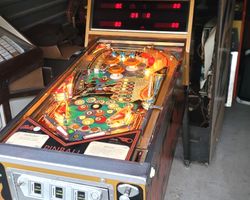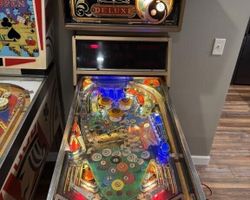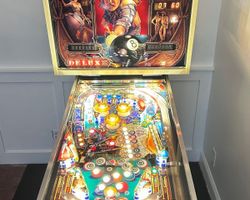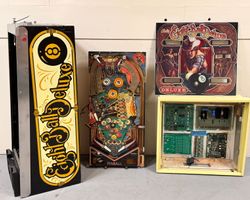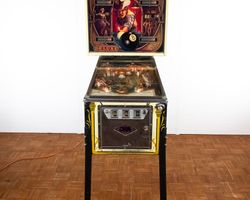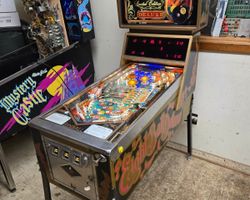Eight Ball Deluxe
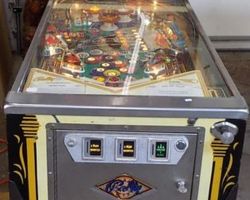
Average Prices: USD $500 to $3,300
Produced: April, 1981
Production Run: 8,250 units
Machine Type: Solid State Electronic
MPU: Bally MPU AS-2518-35
Players: 4
Design by: George Christian
Art by: Margaret Hudson
The pinball machine "Eight Ball Deluxe," released in April 1981 by Bally Manufacturing Corporation, stands as a prominent fixture in the history of solid-state pinball. Designed by George Christian, with artwork by Margaret Hudson and software by Rehman Merchant, this machine drew inspiration from the classic American pastime of billiards, translating the strategic precision of pool into a fast-paced, high-scoring pinball experience. The production run for this original model totaled 8,250 units, a substantial number that reflected its immediate popularity and market impact. Bally, a leading manufacturer of the era, integrated its MPU AS-2518-35 board, ensuring robust electronic gameplay.
A notable technical detail of Eight Ball Deluxe was Bally's adoption of wedge sockets and #555 bulbs for playfield illumination in mass production, a move that began with limited testing on their 1978 title, 'The Six Million Dollar Man'. This transition aimed to improve bulb reliability and simplify maintenance. Early production runs of approximately 400 machines featured white pop bumper caps and bodies, differing from the more widely recognized golden ones. Some of the very first units also incorporated plastic playfields, a variation that eventually gave way to traditional wood due to durability considerations. Unlike some other Bally electronic games, its model number was simply 1220, rather than the extended 1220-E. The machine's success was significant enough to prompt a re-release in 1984 under Bally/Midway, known as Model 0B87, which carried subtle aesthetic differences, including a black apron and varied cabinet art.
Signature Features and Design
"Eight Ball Deluxe" defined its identity through several standout features that directly enhanced the player's engagement. Foremost among these was the integrated custom speech, a relatively new and captivating element for pinball machines of its time. The crisp, digitized voice proclaiming phrases like "Quit talking and start chalking!" immediately drew players into the billiards theme, adding a layer of personality and urgency to the gameplay. This audio feedback was a significant leap from earlier sound effects, providing clear objectives and a compelling reason to keep playing.
The visual design, spearheaded by Margaret Hudson's artwork, was another cornerstone of the machine’s appeal. The backglass, often cited as a particular strength, depicted a stylized billiards hall scene, complete with a "pool shark" character and a sense of inviting challenge. This detailed artwork extended to the playfield, immersing players in the pool hall environment and making the various targets and lanes feel like an authentic extension of a billiard table. The vibrant color palette and distinctive character art gave "Eight Ball Deluxe" a unique visual signature, establishing its theme beyond mere nomenclature.
The primary mechanical features contributing to the machine’s distinctiveness were its twelve drop targets. These were strategically arranged into a 7-bank, a 4-in-line set, and a solitary stand-alone target. Unlike static standup targets, drop targets physically fall away when hit, providing a clear visual and auditory indication of success. This mechanism encouraged precise aiming and offered a satisfying sense of accomplishment as players worked to clear banks and advance game objectives. The three-flipper layout, including a crucial upper-left flipper, further expanded shot opportunities, adding complexity and strategic depth to the playfield interactions.
Playfield and Mechanics
The playfield of "Eight Ball Deluxe" is a masterclass in classic Bally design: an open yet challenging layout that emphasizes shot accuracy and target completion. At its heart lies the central bank of seven drop targets, designed to be sequentially knocked down to spell out "8-BALL." This bank dominates the lower-middle playfield, requiring precise shots from either the left or right main flippers. Directly above this, a set of four in-line drop targets often served to advance bonus multipliers or light other features, demanding a different angle of approach. A solitary drop target might be positioned to award specific points or unlock an extra ball.
The upper-left flipper is a key element of the layout, providing access to an otherwise difficult-to-reach area of the playfield. This flipper enables shots toward the top of the 7-bank, into a kick-out hole for special awards, or to an elevated star rollover, crucial for accumulating points and advancing objectives. The three pop bumpers, positioned strategically in the upper playfield, contribute to the kinetic energy, sending the ball unpredictably into various targets or lanes, requiring quick reflexes and ball control.
Artwork on the playfield, consistent with the backglass, portrays a vibrant billiards theme. Lane guides, inserts, and target areas are adorned with pool cues, billiard balls, and thematic iconography, guiding the player’s eye to critical shots. The lighting, utilizing individual light sockets and #555 bulbs, ensures that lit features and active targets are clearly visible, contributing to a fluid and intuitive play experience. The overall aesthetic of the playfield successfully translates the essence of a lively pool hall into a dynamic pinball environment.
Gameplay Dynamics
Gameplay on "Eight Ball Deluxe" is characterized by its direct objectives and the satisfaction of mastering precise shots. The core progression revolves around clearing the 7-bank drop targets to spell "8-BALL." Once all seven targets are down, the "8-Ball" target itself becomes active, often positioned in a strategic but accessible location, hitting it typically awards a significant score bonus, an extra ball, or a special. This creates a compelling risk-reward scenario, as players must decide whether to go for the high-value shot or focus on other objectives.
Scoring is primarily driven by successfully hitting drop targets, which accumulate points and build a bonus that is awarded at the end of each ball. The 4-in-line drop targets are instrumental in increasing this bonus multiplier, adding another layer of strategic depth. Completing these target banks often lights bonus advance lanes or opens pathways to higher scoring opportunities. The kick-out hole can serve as a skill shot from the plunger, or it can be a target for a well-aimed flipper shot, frequently awarding specific points or lighting an extra ball.
"Eight Ball Deluxe" is known for its fast-paced nature, which can often lead to quick drains if players are not adept at ball control. This challenging aspect contributes to its "one more game" appeal; every drain feels like an opportunity for a better run, pushing players to refine their shot accuracy and flipper timing. Players often develop strategies around systematically clearing the 7-bank, utilizing the upper-left flipper to clean up remaining targets, and then focusing on the bonus multipliers to maximize their end-of-ball scores. The interplay between these straightforward yet demanding mechanics makes each game a test of skill and concentration, fostering an immediate understanding of rules while offering ample room for mastery.
Reception and Legacy
"Eight Ball Deluxe" garnered substantial positive feedback from the pinball community, solidifying its place as a classic. Its strengths largely reside in its engaging gameplay and intuitive rule set. Pinball enthusiasts frequently cite its excellent playfield layout, which balances open space with well-defined target areas, promoting a fluid and satisfying shot-making experience. The implementation of multiple drop target banks is widely praised, offering clear objectives and a tactile sense of progress. The machine’s fast pace, while sometimes leading to swift drains, contributes to an addictive quality, prompting players to start "one more game" repeatedly. The custom speech, particularly the "Quit talking and start chalking!" phrase, is considered ahead of its time and highly memorable, further immersing players in the billiard theme, which itself is often highlighted for its strong and consistent execution through Margaret Hudson’s artwork.
However, the machine is not without its noted characteristics that some players find less appealing. For some, the repetitive nature of its core objective—hitting drop targets—can become monotonous over extended play sessions, particularly for those accustomed to more complex modern pinball machines with deeper rulesets or multifarious modes. Its reputation as a "drain monster" is also a frequent point of discussion, where fast ball times and unforgiving outlanes can lead to frustratingly short games for less skilled players. While the custom speech was innovative, a minority of players eventually find the repeated phrases to be somewhat grating over time. Furthermore, due to its enduring popularity and age, finding an "Eight Ball Deluxe" in pristine condition can be a challenge, as many machines have seen extensive use.
Despite these minor criticisms, "Eight Ball Deluxe" holds a firm and influential position in pinball history. It is frequently regarded as one of Bally's finest machines from the early solid-state era and is a highly sought-after title by collectors globally. Its success demonstrated the enduring appeal of a clear, challenging objective combined with well-executed mechanics. The machine's popularity was such that Bally directly revisited the design with a re-release, a testament to its strong and lasting impact. It helped define the expectations for solid-state pinball machines regarding custom speech, detailed artwork, and engaging target-oriented gameplay, laying groundwork for future designs that would continue to push the boundaries of the medium.
Sponsored Links
 Ebay Listings
Ebay Listings
 Auction Results
Auction Results
| Cost | Location | Date |
|---|---|---|
| USD $2,800 |  Georgia, United States Georgia, United States |
24 December, 2025 |
| USD $1,075 |  Wisconsin, United States Wisconsin, United States |
05 October, 2025 |
| USD $10,000 |  United States United States |
28 August, 2025 |
| USD $12,000 |  California, United States California, United States |
01 August, 2025 |
| USD $9,995 |  Illinois, United States Illinois, United States |
04 May, 2025 |
| USD $2,000 |  Massachusetts, United States Massachusetts, United States |
17 April, 2025 |
| USD $6,949 |  United States United States |
09 March, 2025 |
| USD $6,500 |  Pennsylvania, United States Pennsylvania, United States |
24 January, 2025 |
| EUR €1,900 |  Niedersachsen, Germany Niedersachsen, Germany |
30 December, 2024 |
| USD $6,899 |  United States United States |
11 December, 2024 |


Private Policy · Search Website · Contact Us
As an eBay Partner, we may earn a commission from qualifying purchases made through links on this site, at no additional cost to you.
All trademarks and copyrighted materials remain property of their respective owners. All other content copyright 2007 - 2026 Pinpedia.

